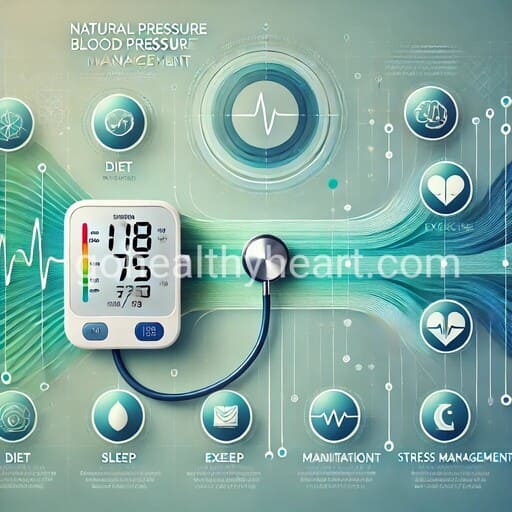Lower Blood Pressure Naturally: 15 Science Backed Methods

Hypertension affects nearly 78 million Americans, yet many are unaware that evidence-based natural solutions exist alongside traditional medications. While medication plays a crucial role in managing hypertension, understanding how to lower blood pressure naturally can provide additional benefits with fewer side effects. This comprehensive guide explores scientifically-proven methods to reduce hypertension through lifestyle modifications, dietary changes, and stress management techniques.
Understanding Blood Pressure
Blood pressure readings consist of two numbers: systolic (pressure during heartbeats) and diastolic (pressure between beats). Normal blood pressure falls below 120/80 mmHg, while readings above 130/80 mmHg indicate hypertension. Various factors influence these numbers, including diet, physical activity, stress levels, and genetics.
According to American Heart Association Journals: “Diet and exercise can lower BP in patients with resistant hypertension. A 4-month structured program of diet and exercise as adjunctive therapy delivered in a cardiac rehabilitation setting results in significant reductions in clinic and ambulatory BP and improvement in selected cardiovascular disease biomarkers.”
Why Choose Natural Methods?
Natural approaches to hypertension management offer several advantages:
- Fewer side effects compared to medications
- Address root causes rather than just symptoms
- Provide additional health benefits beyond hypertension control
- Can work alongside traditional treatments
- Empower individuals to take control of their health
Research published in the Journal of Hypertension shows that lifestyle modifications can reduce systolic blood pressure by 4-11 mmHg, equivalent to some prescription medications.
15 Proven Ways to Lower Blood Pressure Naturally
1. Implement the DASH Diet
The Dietary Approaches to Stop Hypertension (DASH) diet remains one of the most effective natural interventions. This eating plan emphasizes:
- Fruits and vegetables
- Whole grains
- Lean proteins
- Low-fat dairy products
- Limited saturated fats and sugars
Studies show DASH can lower systolic blood pressure by 8-14 mmHg.
2. Reduce Sodium Intake
Limiting sodium to 2,300mg daily (ideally 1,500mg for those with hypertension) can significantly impact blood pressure. Practical steps include:
- Reading food labels
- Cooking at home more often
- Using herbs and spices instead of salt
- Avoiding processed foods
3. Regular Physical Activity
Aim for 150 minutes of moderate aerobic activity or 75 minutes of vigorous activity weekly. Beneficial exercises include:
- Brisk walking
- Swimming
- Cycling
- Light jogging
- Yoga
Regular exercise can lower systolic blood pressure by 4-9 mmHg.
4. Weight Management
Losing just 5-10 pounds can significantly reduce hypertension. Each kilogram of weight loss can lower systolic pressure by about 1 mmHg.
5. Stress Reduction
Chronic stress contributes to hypertension. Effective stress management techniques include:
- Meditation
- Deep breathing exercises
- Progressive muscle relaxation
- Regular physical activity
- Adequate sleep
6. Sleep Optimization
Aim for 7-9 hours of quality sleep nightly. Poor sleep quality correlates with hypertension. Tips for better sleep:
- Maintain a consistent schedule
- Create a relaxing bedtime routine
- Limit screen time before bed
- Keep bedroom cool and dark
- Avoid caffeine late in the day
7. Meditation and Mindfulness
Regular meditation practice can lower systolic blood pressure by 4-5 mmHg. Start with 5-10 minutes daily and gradually increase duration.
8. Increase Potassium Intake
Potassium-rich foods help balance sodium’s effects. Good sources include:
- Bananas
- Sweet potatoes
- Leafy greens
- Avocados
- Tomatoes
Note: Consult your healthcare provider about potassium if you have kidney problems.
9. Limit Alcohol
Moderate drinking or abstinence can lower blood pressure by 4 mmHg. Limits should not exceed:
- Men: 2 drinks per day
- Women: 1 drink per day
10. Quit Smoking
Smoking raises blood pressure and heart rate. Quitting can normalize these values within weeks.
11. Dark Chocolate Consumption
Small amounts (1-2 squares) of dark chocolate (70%+ cocoa) may help lower blood pressure through flavonoid content.
12. Breathing Exercises
Slow, deep breathing for 5-10 minutes daily can reduce systolic pressure by 3-5 mmHg. Try the 4-7-8 technique:
- Inhale for 4 seconds
- Hold for 7 seconds
- Exhale for 8 seconds
13. Herbal Supplements
Some herbs show promise in hypertension management:
- Garlic
- Hibiscus tea
- Hawthorn
- Celery seed
Always consult healthcare providers before starting supplements.
14. Reduce Caffeine Intake
Limit caffeine to 300mg daily. Some people are more sensitive to caffeine’s effects on blood pressure.
15. Regular Monitoring
Track blood pressure regularly to identify patterns and gauge improvement. Keep a log of readings, including:
- Time of day
- Recent activities
- Medication timing
- Food consumption
When to Seek Medical Help
While natural methods can be effective, certain situations require immediate medical attention:
- Readings above 180/120 mmHg
- Severe headaches
- Vision changes
- Chest pain
- Difficulty breathing
Dr. Michael Rodriguez, Director of Preventive Cardiology at Mayo Clinic, emphasizes: “Natural methods work best alongside proper medical supervision. Never discontinue prescribed medications without consulting your healthcare provider.”
Frequently Asked Questions
How quickly can you lower blood pressure naturally?
Some methods, like deep breathing, can show immediate effects. However, sustainable results typically require 2-3 months of consistent lifestyle changes.
What foods help lower blood pressure immediately?
While no food provides instant results, certain items like beet juice, leafy greens, and berries may help within hours through nitric oxide production.
Can lifestyle changes replace blood pressure medication?
Some individuals may reduce or eliminate medication needs through lifestyle changes, but this should only be done under medical supervision.
How much can I lower my blood pressure naturally?
Studies show comprehensive lifestyle changes can reduce systolic pressure by 10-20 mmHg, comparable to some medications.
Conclusion
Lowering blood pressure naturally requires a comprehensive approach combining dietary changes, regular exercise, stress management, and lifestyle modifications. While results may take time, these methods offer sustainable, long-term benefits beyond hypertension control. Remember to:
- Start gradually with manageable changes
- Monitor progress regularly
- Maintain consistency
- Work with healthcare providers
- Stay committed to long-term health
Begin implementing these natural methods today while maintaining any prescribed medical treatments. With patience and dedication, you can take significant steps toward better blood pressure control and overall cardiovascular health.



5 thoughts on “Lower Blood Pressure Naturally: 15 Science Backed Methods”